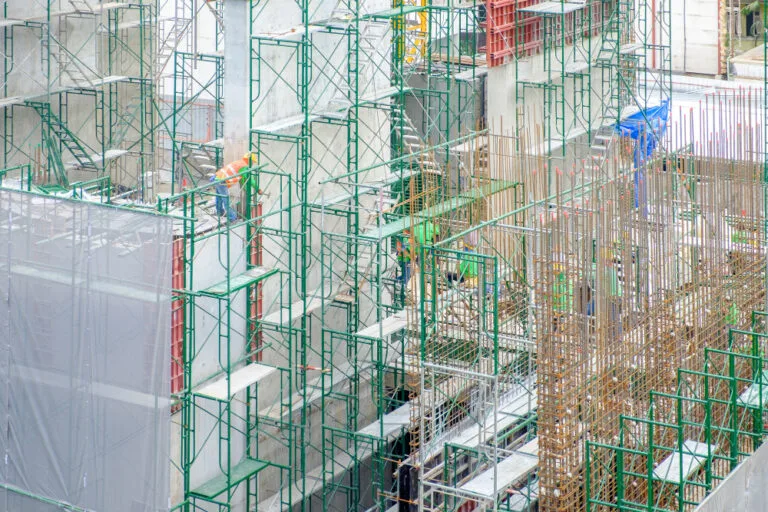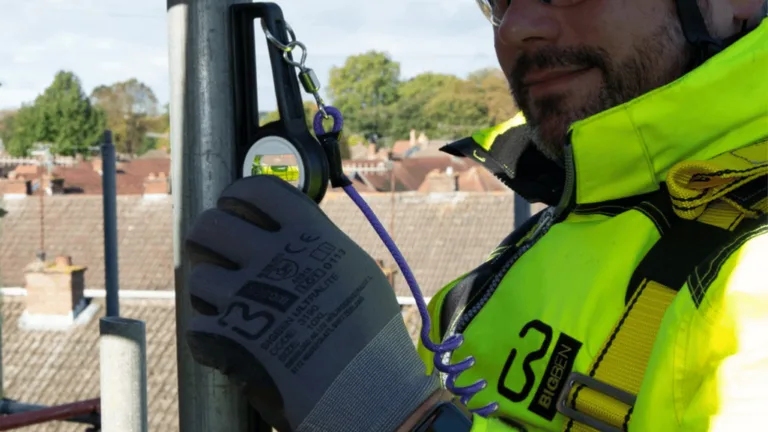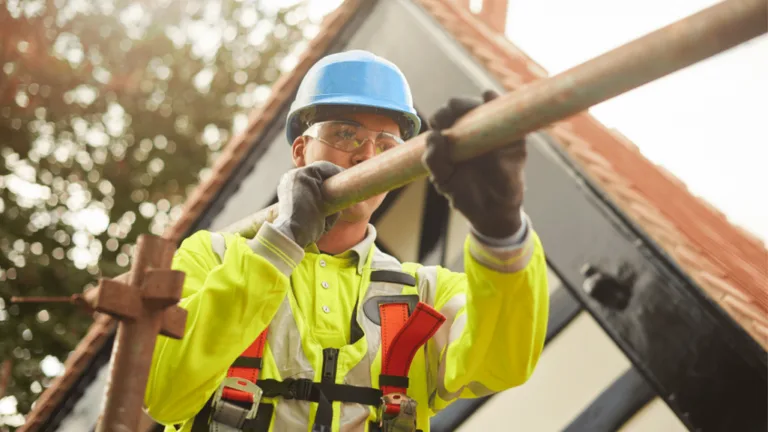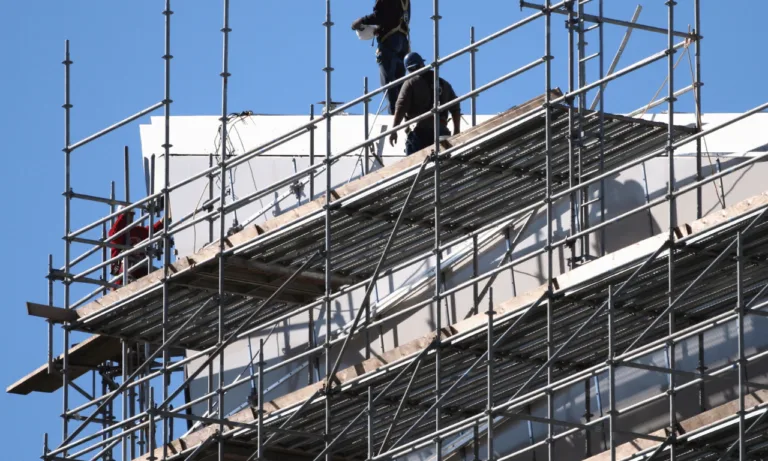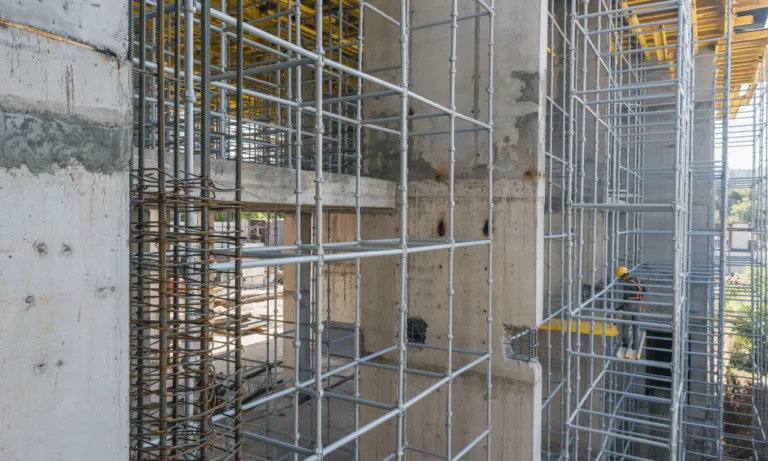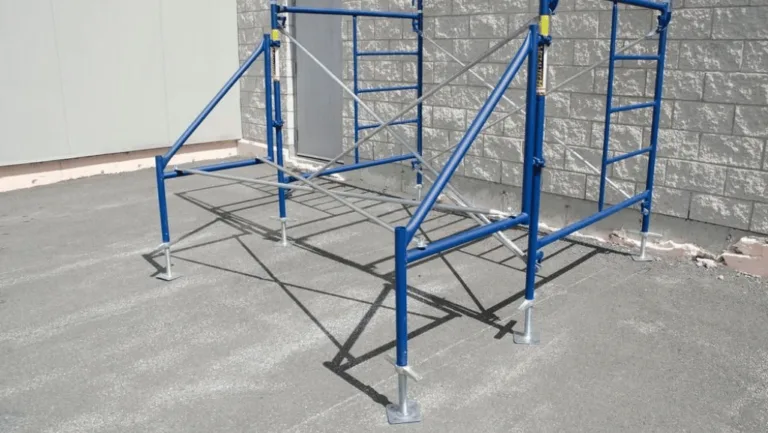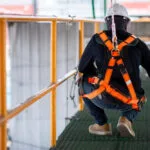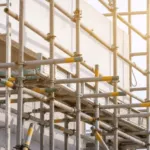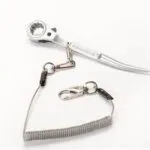Phone:
(+65)8319-0742
Welcome to our comprehensive guide on Personal Fall Arrest Systems (PFAS), an essential element in maintaining safety and compliance in high-risk industries. In this first section, we will explore the importance of fall protection equipment, as well as the regulations set by OSHA and ANSI.
Falls are a leading cause of injuries and fatalities in the workplace, making it crucial for employers to prioritize the safety of their workers. Personal Fall Arrest Systems, including fall protection gear and safety harnesses, play a vital role in preventing falls and protecting individuals working at heights.
Compliance with OSHA Fall Protection Guidelines and the ANSI Fall Protection Standards is not only necessary for legal adherence but also ensures the highest level of safety for workers. Understanding these regulations is paramount for employers, as failure to comply can result in penalties and, more importantly, potential harm to employees.
In the upcoming sections, we will delve deeper into the components of Personal Fall Arrest Systems, provide an overview of OSHA Fall Protection Guidelines and ANSI Fall Protection Standards, guide you in selecting the right fall arrest system for your industry, and emphasize the importance of safety harnesses and other fall protection equipment.
Key Takeaways:
- Personal Fall Arrest Systems are crucial in preventing falls and ensuring worker safety in high-risk industries.
- Compliance with OSHA Fall Protection Guidelines and ANSI Fall Protection Standards is essential for legal adherence and worker protection.
- Understanding the components of Personal Fall Arrest Systems is necessary to select the right fall protection gear.
- Fall protection equipment, including safety harnesses, play a critical role in preventing injuries and fatalities.
- Employers should prioritize employee safety by adhering to OSHA and ANSI standards and providing proper training.
Understanding Personal Fall Arrest Systems
A Personal Fall Arrest System (PFAS) is a crucial component in ensuring the safety of workers in high-risk industries. It consists of various fall arrest system components and fall protection gear that work together to prevent falls and protect individuals working at heights. Let’s explore the key elements of a Personal Fall Arrest System and how they contribute to maintaining worker safety.
Fall Arrest System Components
The Fall Arrest System Components in a PFAS are designed to arrest a potential fall and minimize the risk of injury. The components typically include:
- Safety Harness: A safety harness is worn by the worker and provides support and attachment points for other components of the fall arrest system.
- Shock-Absorbing Lanyard: This component absorbs the impact of a fall by extending and reducing the force exerted on the worker’s body.
- Anchor Point: The anchor point serves as a secure attachment for the worker’s harness and prevents them from falling.
- Connectors: Connectors such as carabiners and hooks are used to link various components of the fall arrest system together.
Fall Protection Gear
Fall Protection Gear is designed to provide additional safety measures and enhance the effectiveness of a Personal Fall Arrest System. Some commonly used fall protection gear includes:
- Fall Protection Lifelines: Lifelines are used to provide continuous support and restrain the worker during movement at heights.
- Rescue Equipment: The use of rescue equipment such as descent devices and rescue harnesses ensures that workers can be safely evacuated in the event of a fall or emergency.
- Fall Protection Helmets: Helmets protect the worker’s head from potential head injuries caused by falling objects or impacts.
By utilizing the appropriate fall arrest system components and fall protection gear, workers can perform their tasks confidently and safely, knowing that they are protected from the risks associated with working at heights.
OSHA Fall Protection Guidelines
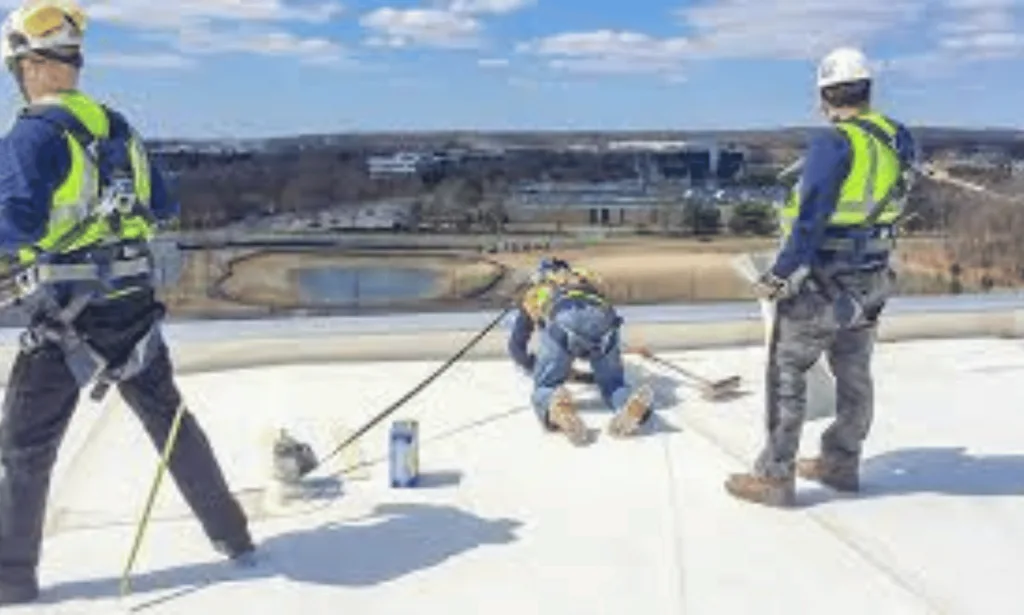
Ensuring proper fall protection is crucial for maintaining safety in the workplace. The Occupational Safety and Health Administration (OSHA) has established guidelines and regulations to protect workers from fall hazards. Compliance with these standards is essential to prevent accidents and injuries related to falls.
To comply with OSHA fall protection guidelines, it is important to understand the specific requirements for personal fall arrest systems (PFAS) and the necessary fall protection equipment. Employers must provide workers with appropriate PFAS and ensure their proper use and maintenance.
Requirements for Personal Fall Arrest Systems (PFAS)
The OSHA fall protection standards specify the following requirements for PFAS:
- The PFAS should be capable of supporting a minimum breaking strength of 5,000 pounds
- The maximum arresting force on the worker’s body should not exceed 1,800 pounds
- The anchorage points used for PFAS should be capable of supporting at least 5,000 pounds per worker
- The PFAS should be rigged to ensure that a worker’s free fall distance does not exceed six feet
- A competent person should inspect and certify the PFAS for safe use at regular intervals
Failing to meet any of these requirements can put workers at risk of serious injuries or fatal falls. Compliance with OSHA standards is critical to ensure a safe working environment.
Training and Inspection
Proper training is essential to ensure workers understand how to use fall protection equipment correctly. Employers should provide comprehensive training on the proper use of PFAS, including how to inspect equipment before each use, identify signs of wear or damage, and maintain it in good working condition.
Regular inspection of PFAS components, such as harnesses, lanyards, connectors, and anchors, is necessary to identify any defects or signs of wear that could jeopardize their effectiveness. Inspections should be carried out by trained individuals who can accurately assess the condition of the equipment and recommend necessary repairs or replacements.
Ensuring Compliance with OSHA Standards
Compliance with OSHA fall protection guidelines involves several key steps:
- Conduct a thorough workplace assessment to identify fall hazards
- Select and provide appropriate fall protection equipment, such as harnesses, lanyards, and connectors
- Train workers on the proper use, inspection, and maintenance of fall protection equipment
- Regularly inspect and maintain fall protection equipment to ensure its effectiveness
- Keep detailed records of training, inspections, and equipment maintenance
By following these guidelines, employers can ensure compliance with OSHA standards and significantly reduce the risk of falls and fall-related injuries in the workplace.
| Benefits of OSHA Fall Protection Guidelines | Key Features |
|---|---|
| Enhanced worker safety | -PFAS requirement for a minimum breaking strength of 5,000 pounds -Maximum arresting force limit of 1,800 pounds on the worker’s body |
| Reduced risk of falls | -Proper training on the use of fall protection equipment -Inspections to identify equipment defects and wear |
| Compliance with legal regulations | -Following OSHA fall protection guidelines to meet industry standards -Maintaining records of training, inspections, and equipment maintenance |
ANSI Fall Protection Standards
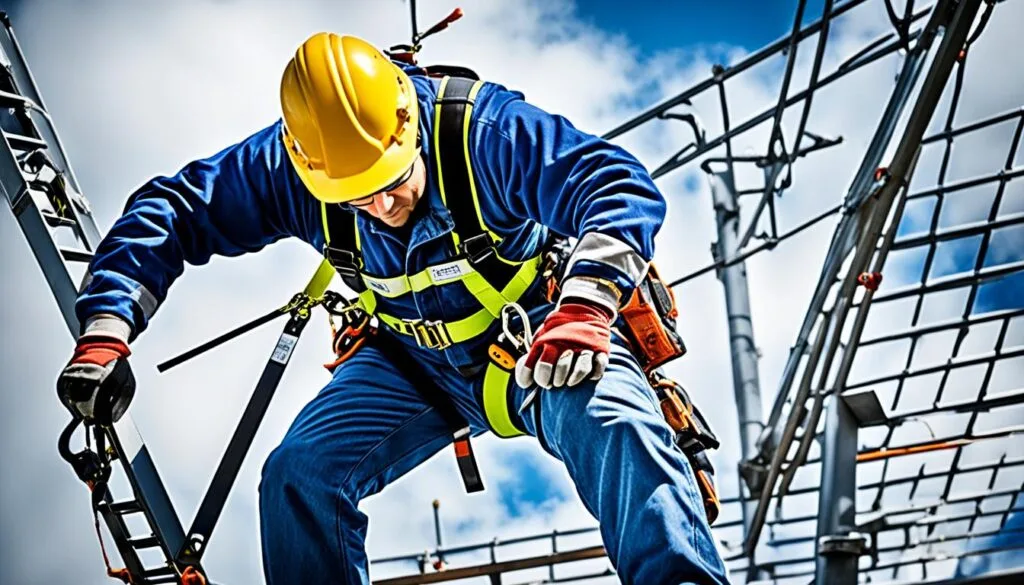
The American National Standards Institute (ANSI) plays a crucial role in establishing guidelines and standards for fall protection in various industries. ANSI fall protection standards outline specific requirements that help ensure the safety of workers at height. These standards help organizations prioritize worker safety and mitigate the risk of falls in high-risk environments.
ANSI fall protection standards cover a wide range of aspects related to fall protection equipment, including:
1. Harnesses and Lanyards
ANSI sets stringent requirements for safety harnesses and lanyards used in fall protection systems. These standards ensure that harnesses are properly constructed, durable, and capable of supporting the weight of the user in the event of a fall. Lanyards are also subject to strict testing and performance criteria to ensure their effectiveness in arresting falls.
2. Anchorage Points
ANSI standards define the specifications for anchorage points to ensure they are strong and reliable enough to support the maximum potential loads imposed during a fall. Properly designed and installed anchorage points are critical for the overall integrity of fall protection systems.
3. Connectors and Fall Arrest Systems
ANSI standards establish requirements for connectors, such as carabiners and snap hooks, used in fall protection systems. These standards ensure that connectors are designed to withstand the forces generated during a fall and prevent accidental disengagement. ANSI also sets guidelines for the performance and functionality of fall arrest systems, which are critical in safely stopping falls and minimizing the impact on the worker.
4. Training and Inspection
In addition to equipment requirements, ANSI fall protection standards emphasize the importance of comprehensive training and regular inspection of fall protection systems. Proper training ensures that workers are aware of the potential hazards and know how to properly use and maintain their fall protection equipment. Routine inspections help identify any defects or damage that may affect the performance of the systems.
Adhering to ANSI fall protection standards is vital for organizations aiming to meet and exceed safety requirements. By following these standards, companies can ensure the reliability and effectiveness of their fall protection systems, thereby reducing the risk of falls and protecting the well-being of their workers.
| Advantages of ANSI Fall Protection Standards | Key Points |
|---|---|
| Enhanced Worker Safety | Compliance with ANSI standards ensures that workers are equipped with high-quality fall protection equipment that withstands the forces of a fall, reducing the risk of injuries and fatalities. |
| Regulatory Compliance | Following ANSI fall protection standards helps organizations meet regulatory requirements, ensuring a safe working environment and avoiding penalties or legal issues. |
| Industry Best Practices | ANSI standards are based on industry best practices and incorporate the latest advancements in fall protection technology, ensuring organizations stay up-to-date with the most effective safety measures. |
| Improved Confidence | Meeting ANSI fall protection standards demonstrates commitment to worker safety, instilling confidence in employees and stakeholders about the organization’s dedication to maintaining a safe work environment. |
Selecting the Right Personal Fall Arrest System
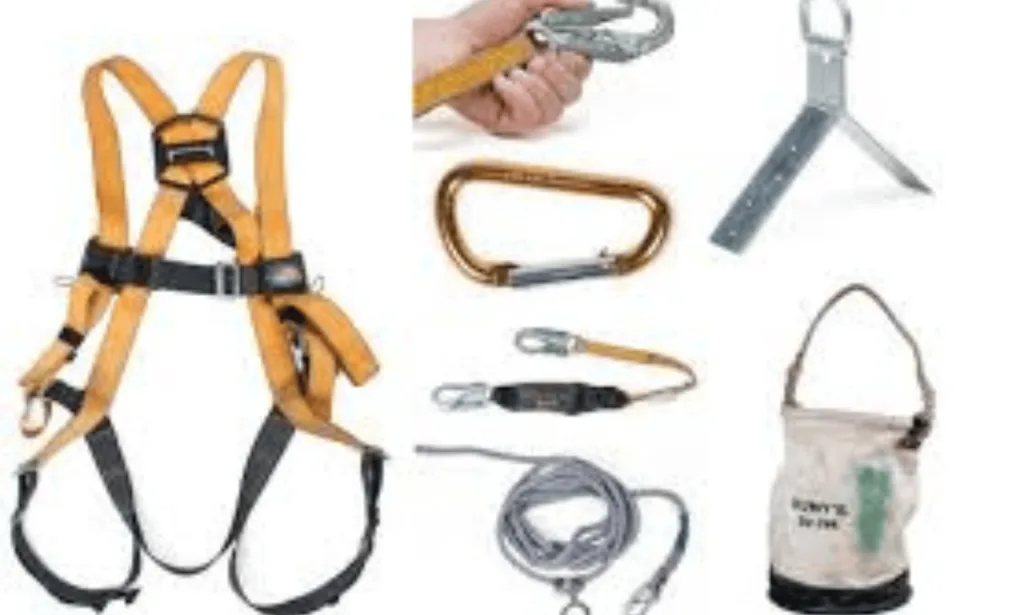
When it comes to maintaining safety and preventing falls in high-risk industries, selecting the right personal fall arrest system is paramount. Whether you’re working in construction or another hazardous environment, choosing the appropriate safety harness and fall arrest harness is crucial for protecting workers and ensuring compliance with construction fall protection systems.
Here are some key factors to consider when selecting a personal fall arrest system:
- Safety Harness: Look for a safety harness that is comfortable, adjustable, and designed to distribute the force of a fall evenly across the body. Consider the type of work you’ll be doing and the specific needs of your industry.
- Fall Arrest Harness: A fall arrest harness is an essential component of a personal fall arrest system. It should be equipped with a shock-absorbing lanyard or self-retracting lifeline to minimize the impact of a fall and prevent serious injuries. Make sure the fall arrest harness meets the necessary safety standards.
- Construction Fall Protection Systems: If you work in the construction industry, it’s essential to choose a personal fall arrest system that complies with the specific requirements of construction fall protection systems. This may include additional features such as tool belts, D-ring extensions, or specialized attachments.
- Fall Protection Gear: Consider the other fall protection gear that may be needed in addition to a safety harness and fall arrest harness. This could include lanyards, lifelines, anchors, or other equipment necessary to create a comprehensive fall protection system.
By carefully considering these factors and selecting the right personal fall arrest system, you can ensure the safety and well-being of workers in high-risk industries. Remember to regularly inspect and maintain your fall protection equipment to ensure it remains in proper working condition.
Comparing Personal Fall Arrest Systems
| Feature | Safety Harness | Fall Arrest Harness |
|---|---|---|
| Comfort | Adjustable straps for a secure yet comfortable fit | Designed to minimize discomfort during prolonged wear |
| Security | Durable construction and secure fastenings | Equipped with shock-absorbing lanyards for added security |
| Specialized Features | Various options available, including tool belt attachments | May have specialized attachments based on industry needs |
| Compliance | Meets industry and safety standards | Compliant with fall protection regulations |
| Additional Gear | Lanyards, lifelines, and anchors may be required | May require additional equipment for a complete fall protection system |
Choosing the right personal fall arrest system is a critical step in ensuring the safety of workers in high-risk industries. By considering the specific needs of your industry, selecting a comfortable and secure safety harness, and adhering to construction fall protection system requirements, you can create an effective fall prevention strategy that keeps workers safe on the job.
Conclusion
In conclusion, personal fall arrest systems are indispensable in high-risk industries for ensuring the safety and well-being of workers. The use of safety harnesses and fall protection equipment plays a critical role in preventing falls and minimizing the risk of injuries or fatalities.
By adhering to the guidelines set by OSHA and ANSI, employers can ensure compliance with safety standards and create a secure work environment. Investing in the appropriate personal fall arrest systems not only protects the workforce but also demonstrates a commitment to safety and regulatory compliance.
It is essential for employers to understand that personal fall arrest systems are not just a requirement but a crucial aspect of workplace safety. By incorporating the right safety harnesses and fall protection equipment, employers can significantly reduce the risk of falls and provide their workers with a secure work environment.
Remember, personal fall arrest systems are an investment in the safety and well-being of your workforce. Choosing the right equipment and following the necessary regulations can make all the difference in preventing accidents and protecting workers in high-risk industries.
FAQ
What are Personal Fall Arrest Systems (PFAS)?
Personal Fall Arrest Systems, or PFAS, are a type of fall protection equipment designed to prevent falls in high-risk industries. They typically consist of a safety harness, a lanyard or lifeline, and an anchor point. These systems are crucial for worker safety and to ensure compliance with regulations set by OSHA and ANSI.
What is the purpose of Fall Protection Equipment?
Fall protection equipment, such as safety harnesses and fall arrest systems, is designed to safeguard workers who are exposed to fall hazards. These devices help prevent falls from heights, reduce the risk of injury, and protect workers from potentially fatal accidents. Selecting the right fall protection gear is essential for maintaining a safe working environment.
What are the OSHA guidelines for Fall Protection?
OSHA, the Occupational Safety and Health Administration, has specific guidelines and regulations pertaining to fall protection in the workplace. These guidelines dictate the requirements for personal fall arrest systems, including the proper use of safety harnesses, the necessity for regular training and inspection, and the implementation of fall protection plans. Complying with OSHA standards is essential for ensuring worker safety and avoiding penalties.
What are the ANSI Fall Protection Standards?
The American National Standards Institute (ANSI) establishes fall protection standards to promote safety in various industries. These standards outline requirements for the design, testing, and performance of fall protection equipment. Adhering to ANSI standards ensures that workers are protected and that the equipment meets rigorous safety standards.
How do I select the right Personal Fall Arrest System?
Selecting the appropriate personal fall arrest system depends on factors such as the specific work environment and industry requirements. It is crucial to consider the type of safety harness that best suits the job tasks, the compatibility of components within the fall arrest system, and compliance with construction fall protection systems if applicable. Consulting with safety professionals and following industry guidelines will help in choosing the right personal fall arrest system.


